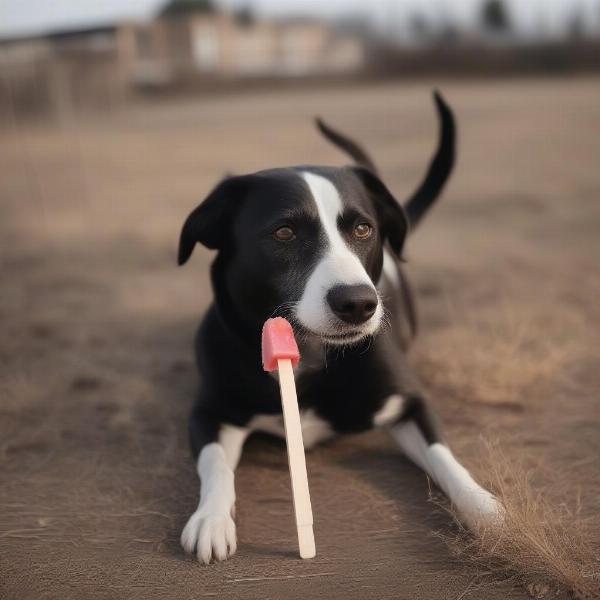Popsicle sticks – those seemingly harmless little pieces of wood – can pose a serious threat to our canine companions. While not inherently poisonous, their shape and size make them a potential choking hazard and can cause internal damage if swallowed. Understanding the risks associated with popsicle sticks and other similar objects is crucial for responsible dog ownership.
The Hidden Dangers of Popsicle Sticks
Many dog owners underestimate the dangers everyday objects present. While we might enjoy a refreshing popsicle, the stick it leaves behind can quickly become a dangerous toy in the eyes of a curious dog. These sticks are small enough to be easily swallowed, but too large to pass through the digestive system without causing problems.
 Dog chewing on a popsicle stick
Dog chewing on a popsicle stick
Swallowing a popsicle stick can lead to a number of serious health complications. The stick can become lodged in the esophagus, causing choking or difficulty breathing. If it makes it past the esophagus, it can obstruct the stomach or intestines, leading to vomiting, diarrhea, loss of appetite, and abdominal pain. In severe cases, surgery may be required to remove the obstruction.
What to Do If Your Dog Swallows a Popsicle Stick
If you suspect your dog has swallowed a popsicle stick, it’s crucial to act quickly. Contact your veterinarian immediately. Do not attempt to induce vomiting unless specifically instructed to do so by your vet. Trying to remove the stick yourself could cause further damage. Observe your dog closely for any signs of distress, such as difficulty breathing, vomiting, or lethargy.
Preventing Popsicle Stick Accidents
The best way to protect your dog is to prevent them from accessing popsicle sticks in the first place. Dispose of used sticks immediately and securely. Never leave them lying around where your dog can reach them. Educate children about the importance of keeping popsicle sticks away from pets. Consider offering your dog safe chew toys to keep them occupied and away from potentially harmful objects.
Is it safe for dogs to eat popsicles?
While a small lick of a popsicle might not harm your dog, it’s generally best to avoid giving them popsicles altogether. Many popsicles contain artificial sweeteners like xylitol, which is highly toxic to dogs. Even sugar-free popsicles can upset a dog’s stomach.
What are some common household items that are dangerous for dogs?
Besides popsicle sticks, common household dangers include cooked bones, string, yarn, rubber bands, grapes, raisins, chocolate, and certain medications. Keep these items out of your dog’s reach.
Other Wooden Objects to Watch Out For
Popsicle sticks aren’t the only wooden objects that can be harmful to dogs. Skewers, toothpicks, and small pieces of wood from furniture or toys can also pose a choking hazard or cause internal damage if swallowed.
Conclusion
Popsicle sticks may seem harmless, but they can be a serious threat to your dog’s health. By understanding the risks and taking preventative measures, you can ensure your furry friend stays safe and healthy. Always supervise your dog, dispose of potentially dangerous objects responsibly, and provide them with safe and appropriate chew toys.
FAQ
- What should I do if my dog is choking on a popsicle stick? Immediately contact your veterinarian or an emergency animal clinic.
- Can popsicle sticks cause splinters in a dog’s mouth? Yes, popsicle sticks can splinter, potentially causing injuries to your dog’s mouth, throat, or digestive tract.
- Are there any safe alternatives to popsicle sticks for dogs? Consider frozen dog treats specifically designed for canine consumption.
- What are the signs of an intestinal blockage in a dog? Vomiting, diarrhea, loss of appetite, abdominal pain, and lethargy can all indicate a blockage.
- How long can a popsicle stick stay lodged in a dog’s digestive system? This can vary, but if you suspect your dog has swallowed something they shouldn’t have, seek veterinary attention immediately.
- Can a small piece of a popsicle stick still be harmful? Yes, even small pieces can splinter or cause blockages.
- Are there any breeds more prone to swallowing foreign objects? Puppies and dogs with strong chewing instincts are generally more likely to swallow non-food items.
ILM Dog is a leading online resource for dog owners worldwide, offering expert advice on all aspects of dog care, from breed selection and health to training and nutrition. We provide reliable, practical information to help you give your canine companion the best possible care. Whether you’re a new dog owner or a seasoned pro, ILM Dog has the resources you need. Learn more about dog care and connect with our experts at [email protected] or by phone at +44 20-3965-8624. Visit ILM Dog for more helpful tips and advice.